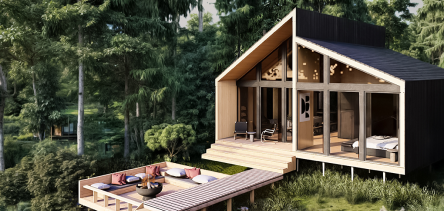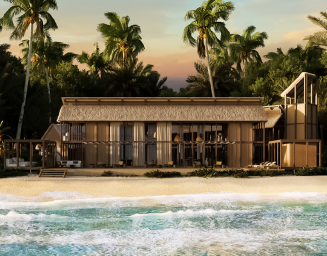10/07/2025 | SIAN
Climate-adaptive prefab homes: SIAN’s sustainable technology for smart projects
Today, more than ever, the climate is a central factor in the way we live. Heatwaves, harsher winters, and environmental variability are no longer occasional events; they are part of our everyday reality. In response to this scenario, at SIAN, we propose a way of building that adapts to and responds to these conditions from the very beginning.
Our climate-responsive prefab homes combine bioclimatic design, efficient construction systems, and practical solutions for diverse contexts, including urban areas, rural settings, real estate developments, and tourism projects. The goal is not only to reduce energy consumption or carbon emissions, although that’s essential, but also to enhance the quality of life of those who inhabit these spaces.
In projects located in temperate, humid, or dry climates, we apply strategies like cross-ventilation, passive shading, solar orientation, and insulation tailored to latitude. The results are consistent: greater thermal comfort, lower energy use, and a superior living experience for both long-term residents and temporary guests.
What are climate-adaptive prefab homes?
A climate-adaptive prefab home is designed from the ground up to respond to its environmental context. This means considering factors like sun exposure, prevailing winds, humidity, latitude, and vegetation while integrating principles of passive solar design and high-performance materials.
At SIAN, these criteria are implemented from the conceptual phase, using a modular, precise, and low-impact system. Each unit is configured based on:
• Strategic solar orientation, allowing for winter solar gain and summer shading.
• Cross-ventilation and natural airflow, with double-glazed argon-filled windows and laminated pine frames.
• Smart thermal insulation, with air chambers between walls, roofs, and floors that can be opened or closed to regulate indoor temperature.
• Ventilated façades and climate-adaptable roofing, including zinc or woven palm, depending on context.
• Sustainable, durable materials such as FSC-certified laminated fir, cement panels, and high-resistance interior finishes.
In modular projects built in mountainous regions, this combination has enabled year-round indoor temperature stability, reducing reliance on artificial climate systems and improving real thermal comfort.
Passive Design + Smart Automation: The ideal balance
Climate isn’t something to fight, it’s something to harness. That’s why every SIAN project combines passive design strategies with advanced smart technology, creating a balance between efficiency and comfort.
In practice, this translates into:
• Thoughtful placement of overhangs, pergolas, and shading elements.
• Automated systems for temperature, lighting, and ventilation control.
• Remote monitoring of energy performance.
• Mobile components that respond in real-time to climate conditions.
These technologies enhance the daily experience for occupants while significantly reducing operational costs. For developers and investors, this means higher resale value, lower maintenance, and stronger positioning in a growing sustainable housing market.
Sustainability is in every decision
When we talk
about sustainable construction, we often focus first on visible materials. However, the real impact is defined much earlier, in key structural decisions: How is the home oriented? How much energy does it need to function? What kind of maintenance will it require over time?
Choosing low-impact materials, such as responsibly sourced wood or durable finishes, is not only an environmental decision. It's also a way to ensure healthier, longer-lasting homes that are well-suited to both the climate and the local economy.
In areas where water is scarce, the power grid is unstable, or access to technical services is limited, a home designed to operate with minimal resources and make the most of what’s available isn’t just efficient, it’s simply the logical solution.
But for us, sustainability goes beyond energy efficiency. It involves a genuine sensitivity to the natural environment where we build. We don’t just design based on climate, temperature, humidity, and solar orientation, but also in dialogue with the landscape, biodiversity, and the identity of each territory.
Designing for the coast is not the same as designing for the mountains, the desert, the jungle, or a mangrove ecosystem. Every place has its rhythm, balance, and character. That’s why we aim for our projects to belong to the place, integrating naturally and respectfully with their context.
Before drawing a single line, we study the vegetation, local fauna, available materials, and the natural dynamics of the area. That’s our starting point. Because we believe that conscious architecture not only improves the experience of living, it also reduces environmental impact and brings lasting, meaningful value to its surroundings.
That commitment to context is what sets our work apart from generic models designed to be replicated without listening to the place.
Benefits that your body and mind are longing for
With climate change and disordered urban growth, environmentally conscious construction is no longer optional; it's essential.
At SIAN, we apply these principles in real and diverse projects: private homes, modular developments, tourist lodgings, and microresorts. We do so through adaptive designs, modular solutions, and efficient construction systems that save time without compromising quality.
Homes that consider climate, territory, and people aren’t just more sustainable—they’re also more viable, more accessible, and more equitable. We believe the future of construction necessarily goes in that direction.
Looking to build with climate in mind?
At SIAN, we support developers, architects, and investors at every stage, from initial concept to turnkey delivery. Our climate-adaptive prefab homes are a real solution for those seeking to build intelligently, responsibly, and with long-term vision.
Explore
our ready-to-go designs or connect with
SIAN Studio for a tailored approach to your next project.
Comments









